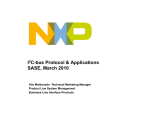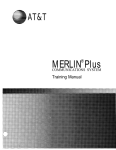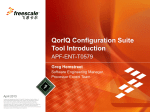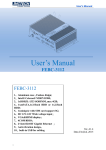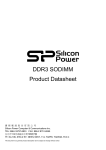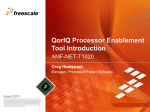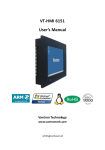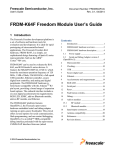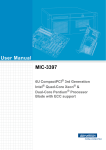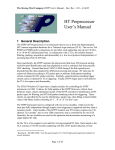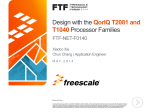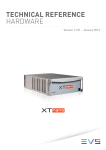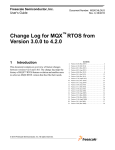Download COM Express Carrier Development System Design Workbook
Transcript
Freescale Semiconductor Design Workbook Document Number: COMEXPRSDS Rev. 1, 02/2011 COM Express Carrier Development System Design Workbook This document primarily describes the COM Express carrier board, its relationship to the whole COM Express development system, and the differences between the carrier board’s architected functions depending on the processor module in use. The COM Express carrier development system, referred to in this document as COMExprsDS, is a high-performance, computing, evaluation, and development platform supporting a single-board computing (SBC) COM Express module based on Power Architecture® processor. The COM Express carrier board is a lead-free, RoHS-compliant board that supports various COMe processor module types. Each COMe processor module (hereafter referred to as COMe module) includes a primary processor or one of its derivatives, and Figure 1 shows how the various modules plug into the common carrier board. © 2011 Freescale Semiconductor, Inc. All rights reserved. Contents 1. COMExprsDS Features and Architecture . . . . . . . . . . 3 1.2. Difficult-to-Find COMe Carrier Connections . . . . 7 1.1. COMExprsDS as a Processor Evaluation System . 5 2. COM Express Carrier Architecture When Used with COMe1-Type Module . . . . . . . . . . . . . . . . . . . . . . . . 11 3. COM Express Carrier Architecture When Used with COMe2-Type Module . . . . . . . . . . . . . . . . . . . . . . . . 30 4. Programming Model . . . . . . . . . . . . . . . . . . . . . . . . . 48 5. Revision History . . . . . . . . . . . . . . . . . . . . . . . . . . . . 49 A. References . . . . . . . . . . . . . . . . . . . . . . . . . . . . . . . . 49 Table 1 shows the processors currently supported by each COMe module type and the orderable part number for each kit. Table 1. Supported Processors and Kit Ordering Information COMe Module Type Processor Kit Part Number COMe1 P4080 P4080COMe-DS-PB COMe2 P2020 P2020COMe-DS-PB Figure 1. How Various Module Types Fit into the Common Carrier Board NOTE In the future, the COM Express carrier board will support the P5020/P5010, P4040, P3041, P2010, P1021, P1020, P1011, P1012, and P1013 devices. Having a common carrier architecture that supports all of these devices as plug-in modules saves development time and money, because many devices can be evaluated with only a single investment in the remaining components of the development system; the peripheral IO modules, chassis, and power supply remain unchanged. The COMExprsDS feature set is determined primarily by the type of COMe module in use and then by the actual processor on the module. Based on this feature set, the development system provides typical OS-dependent resources (disk, Ethernet, and so on) for that configuration. Therefore, this document describes the general development system features first, followed by the COMe module type features, and then the processor device specifics and how they are used by the carrier board. COM Express Carrier Development System Design Workbook, Rev. 1 2 Freescale Semiconductor COMExprsDS Features and Architecture 1 COMExprsDS Features and Architecture The general features of the COMExprsDS are as follows: • Carrier/COMe connectors and supported functions that include the following: — Standard ATX power supply connector — One SD card/MMC connector — Two dual CAN connectors — SerDes PCI-Express (PCIe) connector – Five PCIe x4 connectors (connector “A” through connector “F”), which can support up to four lanes of PCIe 2.0/1.0, SGMII, sRIO, and XAUI, depending on what processor is used – Two PCIe x1 connectors (used as sideband connectors for the PCIe x4 connectors) and one PCIe x1 connector used for a TDM riser to support SLIC functionality — Eight USB2.0 connectors — Four SATA II connectors — One DVI-I connector to support either analog VGA (via an adapter) or digital DVI connector — LVDS A and B ports to support two, single-link DFP (TFT panel) displays with optional LVDS panel and touchscreen functionality — Two UART DB-9 RS-232 connectors (UART0/1 serial ports) that operate at up to 115200 Kbps — One stereo audio jack — Three gigabit Ethernet ports 0/1/3 supporting one dual and one single GMII (1-GHz) RJ-45 Ethernet connectors – One dual-port PHY supporting one dual RMII (100/10-MHz) connector for COMe2 (only for processors that feature QUICC Engine (QE) functionality). — IXXAT – 50-pin connector for Industrial Ethernet Module via SPI bus — Tamper detect circuitry to test out P5020/P3040 security modes — SLIC – RJ-11 phone connectors can be added by using a TDM riser card into slot 5 and the TDM riser sideband connector — RS-485 can be added by adding an adapter to the DB-9 RS-232 connector. • Multifunction FPGA — Routes low-speed and user-defined signals from the COMe module board connectors to the appropriate connectors and devices located on the COM Express carrier board. — Programmed by the processor on the COMe module following a power-up or hard reset. The FPGA functionality varies depending on the specific processor populated on the COMe module. — Generally interfaces to the following signal groups on the COMe module connectors: – Reserved/user-defined – UART2 and UART3 COM Express Carrier Development System Design Workbook, Rev. 1 Freescale Semiconductor 3 COMExprsDS Features and Architecture • • – TDM – SSI – GPI – GPO — Interfaces to the following connectors and devices on the COM Express carrier board for processors that feature QUICC Engine (QE) functionality: – Τwo RS-232 serial ports with corresponding DB9 connectors (UART 2/3) – Two RS-485 serial ports with corresponding DB9 connectors – Four CAN ports with corresponding connectors – UTOPIA module and connector using Freescale PQ-MDS-QOC3 card – HDLC module and connector using Freescale PQ-MDS-16T1E1 card – TDM-based SLIC modules – Fast Ethernet PHY (RMII/MII) – SSI-based CODECs – 1588 header—support is TBD Other functions routed from the COMe module to carrier board devices are: — Local bus – 128-Mbyte NOR FLASH on COMe1 module for Freescale debug purposes only — eSDHC – Connects to SDMedia card slot for boot code or mass storage — SPI – 16-Mbyte EEPROM module for boot code and storage – Control interface for LVDS touchscreen — I2C – Three I2C controllers from COMe module – One I2C2 master implemented in FPGA to read I2C2 EEPROM to determine processor type – I2C1 to I2C expander to generate eight GPIOs (five to FPGA, three to IXXAT module) – I2C2 to control LVDS interface and FPGA I2C2 slave mux/demux for COMe2 (P1021/P1012 only) – I2C3 to control DVI/VGA interface and FPGA I2C3 slave mux/demux for COMe2 (P1021/P1012 only) — Debug features – Legacy COP/JTAG and USBTAP headers for use with CodeWarrior software System logic CPLD and FPGA—other functions — CPLD manages power sequencing — Enabling/disabling of functions based on processor type — Mux/demux functions for QE functions, based on I2C2 or I2C3 slave register settings — I2C1 master reads processor type COM Express Carrier Development System Design Workbook, Rev. 1 4 Freescale Semiconductor COMExprsDS Features and Architecture • • Clocks — SerDes clock – Two clock buffers – Sd_refclk1 pair supports PCIe, and sd_refclk2_p/n supports SGMII and XAUI Power supplies — Power is supplied to carrier board via standard ATX power supply — Power is supplied to COMe module via +12 V pins, VCC_RTC=3.3 V, and VCC_5V_stby = 5 V on the COM Express connectors — 2.5-V power for RMII Ethernet PHY 1.1 COMExprsDS as a Processor Evaluation System For general hardware and/or software development and evaluation purposes, the COMExpress development system can be used like an ordinary, desktop computer. The P4080COMe-DS-PB and P2020COMe-DS-PB development systems can also be used to evaluate many features of the P4080 and P2020 processors, respectively. Table 2 summarizes the processor hardware interfaces that can be evaluated by using the COM Express carrier board; note that shaded features apply to only one processor. Table 2. COMExprsDS Device Interfaces Device Feature SerDes LVDS eSDHC SPI Local bus Serial I2C Configuration Options • Connect to PCI Express slots for use with graphics or other PEX cards • Test via PCI Express card (typically graphics) or Catalyst™ PCI Express control/monitoring card Use ports A or B to test single-link DFP using LVDS TFT LCD panel and touch screen for applicable modules For P2020 only: Supports SDMedia cards and MMC cards Supports standard and x4 devices For P4080 only: Internal debug UART supports two 4-wire serial ports I2C bus #1 can be used for the following: • Boot initialization code • System EEPROM (MAC address storage, serial number, and so on) • Processor EEPROM for COMe module and processor ID from I2C master in the carrier FPGA • Expander to interface to I2C slave in the carrier FPGA (TBD) I2C bus #2 can be used for the following: • RTC on the COMe module • interface to LVDS control I2C bus #3 can be used for the following: • interface to VGA control Clocking GPIO • SerDes clock buffers for XAUI/SGMII/Serial RapidIO and PCI Express slots • RMII clock and buffers Eight GPIOs come from I2C expander COM Express Carrier Development System Design Workbook, Rev. 1 Freescale Semiconductor 5 COMExprsDS Features and Architecture Table 2. COMExprsDS Device Interfaces (continued) Device Feature Configuration Options IRQs EVENT switch normally asserts IRQ* but can drive SRESET0, and/or SRESET1 via software setting Power ATX power supply to COMExpress connector VCC_12, VCC_5_STBY, VCC_RTC_BAT 1.1.1 Development System Use In the absence of special hardware or software configuration, the COMExpress development system operates identically to a development/evaluation system such as ArgoNavis (8641DS) or other members of the HPC family. 1.1.2 Embedded Use Section 2.2, “Carrier Board Configuration Switches When Used with a P4080 COMe1 Module,” and Section 3.2, “Carrier Board Configuration Switches in a System with a P2020 COMe2 Module,” provides the FPGA and external configuration switch settings used for start up configuration information for U-Boot or Linux when the system is used as an embedded platform. COM Express Carrier Development System Design Workbook, Rev. 1 6 Freescale Semiconductor COMExprsDS Features and Architecture 1.2 Difficult-to-Find COMe Carrier Connections Figure 2 highlights connections that are difficult to find on the COM Express carrier board. Key: ATX power connector SW3 power-on button SW1 local reset CPLD programming header FPGA programming header Figure 2. Difficult-to-Find Connections—COM Express Carrier Top View COM Express Carrier Development System Design Workbook, Rev. 1 Freescale Semiconductor 7 COMExprsDS Features and Architecture 1.3 System Logic (CPLD and FPGA) Architecture and Functionality The carrier board contains a CPLD used for power sequencing, and an FPGA that implements the following functions: • Transfers switch settings to processor/board configuration signals • Performs reset sequencing • Enables/disables functions based on processor type • Implements miscellaneous system logic: — I2C timeout reset-TBD The CPLD is implemented with a MAX II, and the FPGA is implemented in an Altera Cyclone III EP3C16F484C8 in a 484-256-pad micro-BGA. Figure 3 shows the overall FPGA architecture. PSU_PWR_GOOD RESET SW CPU CPLD REG RESET SEQ RESETS RESETS CONFIG DRIVE CONFIG REGFILE 8-BIT LAD LBUS LOCAL BUS I2C1 CONFIG I2C EEPROM (debug only) SLAVE MASTER I2CLOGIC Figure 3. CPLD and FPGA Overview COM Express Carrier Development System Design Workbook, Rev. 1 8 Freescale Semiconductor COMExprsDS Features and Architecture Table 3 describes the various FPGA modules. Table 3. FPGA Module Descriptions FPGA Modules RESETSEQ Function Collects various reset/power-good signals and starts the global reset sequencer1, 2 REGRESETS Copies reset signals from the sequencer, but also allows register-based software to individually asserted reset to the local bus, memory, and/or compact FLASH interfaces. REGFILE LOCALBUS CONFIG 1 2 3 4 5 A multi-ported register file containing status and configuration data3 Interface between the processor and REGFILE for internal Freescale debug use only4 Monitors and/or sets selected configuration signals5 I2CLOGIC and I2C1 The I2C1 master reads COMe module EEPROM at address 0xA8 to detect processor type and id information. An I2C slave is also used to select muxes for QE functions via the I2C1 expander FPGA_IO signals (first availability is for P1021 COMe2 module). Power Power for FPGA is supplied from dedicated VCC_HOT_3.3 and VCC_HOT_1.5-V power supplies based upon the ATX power supply +5-V standby power, VCC5STDBY. ASLEEP indicates that the processors(s) have exited the reset state. It does not cause a reset, because the processor can sleep for any number of reasons after hard reset is completed. During power-down, all I/O and output drivers are tristated. After power up, drivers may be driven. Normal operation and/or use of the VELA engine may cause some I/Os to be tristated. REGFILE must be able to accept (or arbitrate for) concurrent writes to the same register, though this is not a statistically likely occurrence. Because access to the internal registers may be blocked, asynchronous (not ready) signalling is used. In some instances, CONFIG maps switch settings into direct configuration outputs, while in others (such as SYSCLK), it maps a 3-position switch into a 16-bit register initialization pattern, which is subsequently used to initialize the clock generator. 1.4 System Power Connections Between Carrier Board and COMe Module The 12-V, 5-V, and 3.3-V power requirements of the carrier board are met by the attached ATX-12V compatible power supply unit (PSU) of the COMExprsDS. 5 V and 3.3 V are connected to individual power planes in the COMExprsDS PCB stackup. The 12-V power from the standard ATX header is treated as separate from the ATX-12V power, which supplies a large amount of current and is referred to as “VCC_12V_BULK” to the COMe module. Other supplies include VCC_5VSTBY, and VCC_BAT. Note that to support the FPGA standby operation, video cards, or other high-power-dissipation cards in the PCI Express slot, the PSU should support the following minimum specifications: • Minimum 450 W overall, 500 W recommended • One PCIE 12-V connector (TBD) • PCIE 12 V supports a minimum of 150 W • Minimum 5-V, 2-A standby current COM Express Carrier Development System Design Workbook, Rev. 1 Freescale Semiconductor 9 COMExprsDS Features and Architecture All other power sources are also derived from the ATX PSU. Figure 4 shows the principal system power connections in relationship to the CPLD control. For more detail about the processor power scheme implemented by this system, see “Power” in Table 3. ATX PSU PWRON PWRGD +3.3VHOT +5VSTB SPS Raptor +1.8VHOT LDO +5 V LDO +2.5 V LDO +1.8 V LDO +1.2 V Select VSTANDBY +3.3 V +12 V +3.3 V HOT +12V_BULK Batt. Figure 4. COMExprsDS System Power Supplies COM Express Carrier Development System Design Workbook, Rev. 1 10 Freescale Semiconductor COM Express Carrier Architecture When Used with COMe1-Type Module 2 COM Express Carrier Architecture When Used with COMe1-Type Module As described earlier, the architecture and feature set of the carrier board depends on the module type with which it is used. Figure 5 depicts the general features and connectivity of the COM Express carrier board when used with a COMe1-type module board. COMEXPRESS CARRIER (COMe1) 3 x RJ-45 MIDI GBE0-3 4 USB 2.0 ports 4 DUAL USE HDRS 4 USB 2.0 ports Only UART3 RS-485 Adapter NOR Flash LBC QE/UART/ User-defined GPIO SPIFlash DVI/VGA LVDS TouchIF SPI SPIFlash SDHC SD/MMC conn SB Lanes 16-19 2Singlelink DFP CONN Lanes 20-23 DVI Lanes 24 Lynx2 PCIe slot5 Lanes 4-7 PCIe slot4 Lynx1 PCIe slot3 PCIe slot2 Lanes 0-3 DVI-I FPGA IXXAT (IEM) CONN I2C#3 I2C#2 VGA CLOCKS ATX CONN 5 GPIOs 3 GPIOs I2C Expander SB 1588 SIGNALS 1588 HDR I2C#1 Tamper det hdr STM1403A SECURITY PCIe slot1 CAN 4CAN CONN FSL COMe Connector UART2/3 RS232 FPGA and External Muxes Dual DB9 sata3 LVDS A/B SATA x1 sata2 sata1 sata0 FAN HDR Dual DEM9 RS232 UART0/1 Figure 5. COM Express Carrier Block Diagram When Used with COMe 1-Type Module COM Express Carrier Development System Design Workbook, Rev. 1 Freescale Semiconductor 11 COM Express Carrier Architecture When Used with COMe1-Type Module 2.1 System Reset Performed by FPGA Reset Sequencer in a System with a COMe1 Module The carrier board FPGA contains a reset sequencer that properly manages the orderly bring-up of the system (this is not the same as the power sequencer, which is similar, but not specifically related to reset). After the system transitions to having fully stable power supplies, the reset sequencer does the following: 1. Waits for all reset conditions to clear 2. Configures and releases the processor from reset 3. Idles waiting for further reset conditions to occur Table 4 summarizes the reset conditions and actions of the FPGA when used with a COMe1 module. Table 4. Reset Conditions and Actions of FPGA Reset Sequencer Signal Type Description Action HOT_RST_B External HOT power stable Restarts all FPGA internal state machines and registers PWRGD External ATX power stable Causes full system reset unless the system is in S3 (power down) state SYS_HRST_B External COP tool reset request Upon power good, sys_rst_b is sent from carrier to COMe1 module RESET_REQ_B External CPU requests reset 2.2 Full reset Carrier Board Configuration Switches When Used with a P4080 COMe1 Module There are different types of carrier board configurations. A list of these configuration types and their implementation is shown in Table 5. Table 5. Carrier Board Configuration Types Configuration Type Implementation Requires software configuration to Implemented with “DIP switches” and/or software-settable options support evaluation Expected to be easily or often changed by the end-user or developer COM Express Carrier Development System Design Workbook, Rev. 1 12 Freescale Semiconductor COM Express Carrier Architecture When Used with COMe1-Type Module The carrier board switches and their default settings when used with a P4080 COMe module are shown in Figure 6. Switch names exactly match the name on the schematics and on the printed-circuit board in most cases, except where a spare has been newly assigned and only the FPGA has changed. Figure 6. Carrier Board Switch Assignments and Defaults When Used with P4080 COMe Module COM Express Carrier Development System Design Workbook, Rev. 1 Freescale Semiconductor 13 COM Express Carrier Architecture When Used with COMe1-Type Module For those signals configured using switches, the configuration logic is as shown in Figure 7. EEPROM OVDD SW1 EN1 SW2 EN2 ... P4080 FPGA CFGDRV ENx.y SWx.y CONFIG_PIN where needed Figure 7. COMe1 Configuration Switch Logic and P4080 The default action is for the FPGA to transfer the switch setting to the processor configuration pin during the CB_RESET_B assertion interval. For certain COMe modules, the I2C expander FPGA IO signals can select the multiplexer configurations. COM Express Carrier Development System Design Workbook, Rev. 1 14 Freescale Semiconductor COM Express Carrier Architecture When Used with COMe1-Type Module 2.3 COM Express Carrier Board Functionality when Used with a P4080 COMe1 Module The ways in which the COMe1 module affects the functionality of the carrier board also depends on the specific processor used in the COMe1 module. This section and its subsections are tailored to the carrier board functionality when used with the P4080 COMe1 module specifically. Figure 8 shows the P4080 COMe module block diagram. Note that functional modules that only exist on the COMe module are described in the COMX-P4080 COM Express Module installation and user manual. x4 PCIe 4x1G-SGMII 4x1G-SGMII 10G-XAUI 10G-XAUI x4SERDES x4SERDES either here or there 4x1G-SGMII x4 PCIe x4 PCIe x4SRIO x4SRIO 8xSERDES Aurora Debug 2xSERDES SO-DIMM DDR3 1333/1600 72-bit SO-DIMM DDR3 1333/1600 72-bit Freescale P4080 5020/4080 10G-XAUI / x4PCIe / 4x1G-SGMII x4PCIe/4xSRIO/4x1G SGMII x4PCIe/4xSRIO 1G-T RGMII 1G-T PHY RGMII/USB 1G-T PHY 1G-T 5020/3041 5xUSB USB 4xUSB2.0 USB2.0 Hub PHY 5xUSB USB USB ULPI 4xUSB2.0 USB2.0 Hub PHY 5020/3041 USB PHY 5020/3041 5020/3041 USB PHY COM-E 2xUART(Tx/Rx/CTS/RTS) Connectors SPI SDIO/MMC 2xSATA 4xI2C 5020 SPI (3 CS#) Debug Header JTAG/COP SD/MMC Debug Header x1 Aurora 2x USB2.0 ULPI 4xI2C RTC_CLK 2xRGMII 2xUART (Tx/Rx/CTS/RTS) Or 4xUART (Tx/rX) Local Bus 2xIEEE-1588 LocalBus RTC/ WDT RTC_BAT WDT 8xGPIO NOR Flash Uboot FW NAND Flash OS/App 1588 (Trig/Alarm/Clock/Pulse/Stamp-Tx/Rx) Reset Tamper Detect Figure 8. P4080 COMe Module Block Diagram 2.3.1 Carrier Board Use of P4080 DDR Interface See the COMX-P4080 COM Express Module installation and user manual. COM Express Carrier Development System Design Workbook, Rev. 1 Freescale Semiconductor 15 COM Express Carrier Architecture When Used with COMe1-Type Module 2.3.2 Carrier Board Use of P4080 SerDes x18 Interface The SerDes block on the P4080 provides high-speed serial communications interfaces for several internal devices. The SerDes block on the P4080 COMe1 module provides 18 serial lanes for the carrier that may be partitioned as shown in Table 6. Note that the term ‘lane’ is used to describe the minimum number of signals needed to create a bidirectional communications channel; in the case of PCI-Express or Serial RapidIO, a lane consists of two differential pairs, one for receive and one for transmit, or four in all. Table 6, top down, shows the following clocking banks and how they are configured by the carrier board: • Bank1—lanes A–D go to slot 1, E–H to slot 2, and I–J to the Aurora debug connector • Bank2—lanes A–D go to slot 3 • Bank3—lanes A–B go to SATA ports 1 and 2 Table 6. P4080 SerDes Lane Multiplexing Configurations on Carrier Bank 1 Bank 2 Bank 3 A B C D E F G H I J A B C D A B C D 0 1 2 3 4 5 6 7 8 9 10 11 12 13 14 15 16 17 SATA Port1 SATA Port2 — — Aurora Conn on COMe Module SLOT 3 PCIe2 (5/2.5G) Debug (5/2.5G) XAUI FM2 SATA1 SATA2 — — PCIe1 (5/2.5G) SGMII SGMII SGMII SGMII FM2 FM2 FM2 FM2 Debug (5/2.5G) XAUI FM2 SATA1 SATA2 — — sRIO2 (2.5G) sRIO1 (2.5G) Debug (5/2.5G) XAUI FM2 SATA1 SATA2 — — sRIO2 (2.5G) sRIO1 (2.5G) Debug (2.5G) SGMII SGMII SGMII SGMII SATA1 SATA2 FM2 FM2 FM2 FM2 — — sRIO2 (2.5G) sRIO1 (2.5G) Debug (5/2.5G) PCIe3 (5/2.5G) SATA1 SATA2 — — PCIe1 (5/2.5G) sRIO1 (2.5G) Debug (5/2.5G) XAUI FM2 SATA1 SATA2 — — SLOT 1 SLOT 2 PCIe1 (5/2.5G) COM Express Carrier Development System Design Workbook, Rev. 1 16 Freescale Semiconductor COM Express Carrier Architecture When Used with COMe1-Type Module PEX Slot 1 P4080 SD_TX/RX[0:3](p,n) SD_TX/RX[8:9](p,n) COMEXPRS CONN SD_TX/RX[4:7](p,n) TX/RX[0:3](p,n) PCIe/SRIO Cards PEX Slot 2 TX/RX[4:7](p,n) Aurora Conn PCIe/SGMII/SRIO Cards Aurora Debug Connector TX/RX[1:0](p,n) REFCLK_SD1(p,n) 100 MHz Figure 9. P4080 SerDes Bank1 to Carrier Board Cards/Debug Connector Configuration COM Express Carrier Development System Design Workbook, Rev. 1 Freescale Semiconductor 17 COM Express Carrier Architecture When Used with COMe1-Type Module SD_TX/RX[10:13](p,n) SD_TX/RX[14:15](p,n) COMEXPRS CONN P4080 PEX Slot 3 TX/RX[0:3](p,n) PCIe/SGMII/XAUI Cards SATA port1 & 2 SATA connectors TX/RX[1:2](p,n) REFCLK_SD2/3(p,n) 125 MHz Figure 10. P4080 SerDes Bank 2 and 3 to Carrier Board Cards/SATA Connector Configuration NOTE The SD2 and SD3 clocking domains use separate clock generators. 2.3.3 Carrier Board Use of P4080 Ethernet Controller (EC) Interfaces The carrier board uses up to two 10/100/1000baseT triple-speed Ethernet controllers (ECs) of the P4080 in one of the following configurations: • EC2 is connected to the on-board PHY using the RGMII protocol; the remaining ports are unused. or • Both ECs are independently connected to a ULPI USB interface; for the COMExprsDS, EC2 routes via the ULPI to a USB PHY. COM Express Carrier Development System Design Workbook, Rev. 1 18 Freescale Semiconductor COM Express Carrier Architecture When Used with COMe1-Type Module P4080 ENET PHY EC #1 1 EC #2 2 COMEXPRS CONN MI To USB2 Port #1 Port #2s Port #3 GTXCLK CLKBUF 125 MHz Figure 11. P4080 Ethernet Connections to the Carrier Board Table 7 summarizes the carrier board EC connections and routing when the COMe1 is populated with a P4080. Table 7. P4080 Ethernet Port Locations on Carrier P4080 EC # Connection Port PHY Address Location 1 1 0 Conn. P9 top 2 2 1 Conn. P9 bottom See Section 2.3.8, “Carrier Board Use of P4080 USB Interfaces,” and COMX-P4080 COM Express Module installation and user manual for more details on the use of these interfaces. COM Express Carrier Development System Design Workbook, Rev. 1 Freescale Semiconductor 19 COM Express Carrier Architecture When Used with COMe1-Type Module 2.3.4 Carrier Board Use of P4080 Support for IEEE Std 1588™Protocol The carrier board supports the P4080 IEEE 1588 precision time protocol (PTP) as shown in Figure 12. This facility works in tandem with an Ethernet controller to time-stamp incoming packets. P4080 TX > 1588 ALARMOUT[1:2] TRIGIN[1:2] STMP_TX/RX[1:2] XTALOSC 125.000 MHz ±25 ppm CLKIN CLKOUT P6880 Debug Header PULSEOUT[1:2] Figure 12. P4080 IEEE 1588 Interface to Carrier Board P6880 Debug Header 2.3.5 Carrier Board Use of P4080 Local Bus Interface See the COMX-P4080 COM Express Module installation and user manual for details. Local bus connection to the carrier board is for Freescale internal use only. COM Express Carrier Development System Design Workbook, Rev. 1 20 Freescale Semiconductor COM Express Carrier Architecture When Used with COMe1-Type Module 2.3.6 Carrier Board Use of P4080 eSDHC Interface The P4080 has an enhanced secure digital host controller (eSDHC). The carrier board connects the P4080 eSDHC to an SDMedia card slot and uses GPIO signals for sideband signals, such as write-protect-detect and card-detect. Both x4 and x8 cards are supported, the latter using the SPI_CS_B[0:3] signals, which can be reassigned as eSHDC_D[4:7]. P4080 SDMedia Slot SDHC_CMD SDHC_CLK SDHC_CD SDHC_WP SDHC_DAT[4:7] COMEXPRS CONN SDHC_DAT[0:3] CMD DAT[0:3] CLK SDHC_CD_B SDHC_WP_B CD_B WP_B DAT[4:7] SD CFG_SDX8MUX Figure 13. P4080 eSDHC Interface to Carrier Board SD Media Card Slot NOTE SDHC_DAT[4:7] are shared with the SPI CS pins; the CFG_SDX8MUX switch selects the routing of those pins to either the SDHC devices or the SPI devices, but both cannot be used simultaneously. COM Express Carrier Development System Design Workbook, Rev. 1 Freescale Semiconductor 21 COM Express Carrier Architecture When Used with COMe1-Type Module 2.3.7 Carrier Board Use of P4080 SPI Interface The P4080 has a serial peripheral interface (SPI), which is used to communicate with various peripherals. The COM Express carrier board connects a conventional 16-Mbyte serial SPI FLASH EEPROM to one chip-select of the P4080 SPI interface. The remaining three chip-selects are unused. P4080 SPI_MOSI SPI_MISO SPI_CS0_B COMEXPRS CONN SPI_CLK SPI FLASH 16 Mbytes SPI_CS1_B SPI_CS3_B MUXES SPI_CS2_B cfg_SDX8MUX sw_FLASHWP_B Figure 14. P4080 SPI Interface Connection to Carrier SPI FLASH Slot COM Express Carrier Development System Design Workbook, Rev. 1 22 Freescale Semiconductor COM Express Carrier Architecture When Used with COMe1-Type Module 2.3.8 Carrier Board Use of P4080 USB Interfaces The P4080 has a USB 2.0 port that uses the UTMI+ protocol to connect to an external USB PHY, and it may be configured for host or device modes of operation.The carrier board USB port connector is a female “Type A” (the standard connector for a host to communicate with keyboards, mice, memory sticks, and so on). Four USB PHYs and Two 5xHUB USB_D[0:7] DATA[0:7] USB_NXT NXT USB_DIR DIR USB_STP STP USB_CLK CLKOUT DP DM VBUS IRQ5 EXTVBUS COMEXPRS CONN P4080 CPEN USB PortS MIC2076 USBPWR (overcurrent) Figure 15. P4080 USB Connection to Carrier Board USB Interfaces See the COMX-P4080 COM Express Module installation and user manual for details about the four PHYs and the two 5xHUBs. 2.3.9 Carrier Use of P4080 DMA Controllers The P4080 DMA controllers have internal and external controls to initiate and monitor DMA activity. The carrier board does not incorporate any specific devices that make use of the external pin-controlled DMA controllers. The P4080 DMA ports are connected to test points on the carrier board to allow external hardware control, as needed. COM Express Carrier Development System Design Workbook, Rev. 1 Freescale Semiconductor 23 COM Express Carrier Architecture When Used with COMe1-Type Module 2.3.10 Carrier Use of P4080 eOpenPIC Interrupt Controller The carrier board contains numerous interrupt connections. The P4080 eOpenPIC connections to the carrier are shown in Table 8. See the COMX-P4080 COM Express Module installation and user manual for more details on all of the interrupt signals implemented by the module. Table 8. P4080 eOpenPIC Interrupt Connections to Carrier Board Devices Signal Name Connections IRQ0_B SLOT3 sideband connector (SGMII riser does not connect; must use in-band irq) IRQ1_B DS3232 real-time CLOCK and NVRAM IRQ2_B — IRQ3_B — IRQ4_B — IRQ5_B MIC2076 USB Power FLAG for over current at USB connector IRQ6_B — IRQ7_B Not connected IRQ8_B FPGA-TBD IRQ9_B FPGA-TBD IRQ10_B — IRQ11_B — IRQ_OUT_B Not used as Interrupt, but as an EVT pin 2.3.11 Carrier Use of P4080 GPIO Signals The I2C1 interface on the P4080 is expanded by routing five P4080 GPIO signals to the carrier board FPGA for general usage and routing three GPIO signals for controlling the IXXAT module. In the future, the FPGA could alternatively be implemented to use these GPIO signals to support EMI MDIO bus multiplexing as shown in Table 9. Currently, switches can be used, or the FPGA can automatically detect that I/O cards are in slots 2 and 3 and set the EMI value accordingly. Table 9. Future Options for Configuring P4080 Dedicated GPIO Signals for EMI MDIO Bus Multiplexing Signal Name System Function GPIO[0:1] EM1 management bus mux control GPIO[2:3] EM2 management bus mux control GPIO[4:7] Spares connected to test points COM Express Carrier Development System Design Workbook, Rev. 1 24 Freescale Semiconductor COM Express Carrier Architecture When Used with COMe1-Type Module 2.3.12 Carrier Use of P4080 Control Signals The carrier board implements SYS_RESET_B to reset the entire development system, and CB_RESET_B in turn sends a reset to the FPGA from the COMe module. P4080 COMe1 Module SYS_RESET_B FPGA CB_RESET_B Figure 16. P4080/COMe1 System Reset Connection with Carrier Board FPGA 2.3.13 Carrier Board Use of P4080 UART Serial Ports The carrier board connects both 4-wire serial ports of the P4080 to serial level transceivers, and from there to a stacked dual DB9 male connector placed on the front panel UART I/O board that is located at the front of the chassis. The default mode is 4-wire, so RTS/CTS flow control is supported on these connectors. For the P4080DS kit (P4080COMe-DS-PB), UART ports 0 and 1 are supported. +3.3 V MUX LT1331 UART 0 Port #1 Top port LT1331 UART 1 COMEXPRS CONN P4080 Port #0 Bottom port HOT +3.3 V cfg_pixisuart Figure 17. P4080 UART Serial Port Connection to Carrier Board Serial Port Connector COM Express Carrier Development System Design Workbook, Rev. 1 Freescale Semiconductor 25 COM Express Carrier Architecture When Used with COMe1-Type Module 2.3.14 Carrier Board Use of P4080 I2C Interfaces I2C2 I2C3 I2C1_MAS I2C2_SLAVE I2C3_SLAVE LVDS I2C1 FPGA DVI/VGA EEPROM P4080 COMEXPRS CONN The carrier board uses three of the four available I2C/SMB buses. The I2C1 master from the FPGA accesses the EEPROM on the COMe module to read 256 bytes of EEPROM (processor type) data before the carrier system reset is asserted to the module Figure 18. IP4080 I2C Connectivity to Carrier Board FPGA The P4080 I2C bus device addresses on the carrier board are summarized in Table 10. Table 10. P4080 I2C Bus Device Map for Carrier Board I2C Bus I2CAddress Device Notes 1 0x21 Reserved — 1 0x22 Reserved — 1 0x23 IO Expander Philips PCA9555PW Not used for P4080 module. Reserved. 1 0x34 CODEC Wolfson WM8776SEFT Not used for P4080 module. Reserved. 1 0x64 DDR3 DIMM2 On P4080 COMe module 1 0x66 DDR3 DIMM1 On P4080 COMe module 1 0x98 Thermal sensor ON Semiconductor ADT7461ARMZ On P4080 COMe module 1 0xA0 4-Kbyte EEPROM Boot configuration I2C EEPROM on P4080 COMe module Atmel AT24C02C or equivalent 1 0xA4 Remote I2C IO Expander On carrier. Read only. See datasheet for programming instructions Philips PCA9672PW Device ID 1 0xA8 4-Kbyte EEPROM Stores 256 bytes of processor type data. Atmel AT24C64A or equivalent. Write protectable. 1 0xD0 RTC On P4080 COMe module COM Express Carrier Development System Design Workbook, Rev. 1 26 Freescale Semiconductor COM Express Carrier Architecture When Used with COMe1-Type Module Table 10. P4080 I2C Bus Device Map for Carrier Board (continued) I2C Bus I2CAddress Device Notes 1 0xDC Clockgen for SD BANK1 IDT 9FG104DGILFT On P4080 COMe module 1 0x57 I2C slave port Not used for P4080. Reserved. 2 0x58 USB HUB2 On P4080 COMe module 2 0x60 6-bit DAC Maxim MAX5362LEUK Not used for P4080 module. Reserved. Note: These addresses do not include the position of the LSB of the transmitted address (the read/write bit). See Section 4, “Programming Model,” for I2C implementation information. 2.3.15 Carrier Board Use of P4080 EM1 and EM2 Management Buses The P4080 has the following types of buses: • SGMII and RGMII PHY management • XAUI PHY management Because one set of buses must span across multiple devices on the carrier board, multiplexers are used to route from the P4080 to each PHY, and switches are used to control these multiplexers. PHY management bus control is summarized in Table 11 and Table 12. Table 11. P4080 PHY Management Bus Map for EMI1 on Carrier Board Bus SW4[3:4] Device EMI1 00 On board RGMI PHYI EMI1 01 Slot 2 SGMII EMI1 10 Slot 3 SGMII Table 12. P4080 PHY Management Bus Map for EMI2 on Carrier Board 2.3.16 Bus SW8[4:5] Device EMI2 00 No Device EMI2 01 No Device EMI2 10 No Device EMI2 11 Slot 3 XAUI Carrier Board Use of P4080 Debug Features The carrier board provides a JTAG COP header and AURORA test points for debug purpose using the CodeWarrior USBTAP already installed in the system. COM Express Carrier Development System Design Workbook, Rev. 1 Freescale Semiconductor 27 COM Express Carrier Architecture When Used with COMe1-Type Module To upgrade the U-Boot stored on the COMe module’s NOR FLASH, use the CodeWarrior USBTAP tool. See the COMX-P4080 COM Express Module installation and user manual and Mentor Embedded Linux For Freescale COMe P2020 System Builder Quick Start Guide for more details. 2.3.17 Carrier Board Clock Generation from P4080 COMe1 Module Board The carrier board clock signals are generated by the COMe module board in use. Table 13 lists the requirements of the carrier board clock signals when the carrier board is populated with a P4080 COMe1 module. For more details on the P4080 COMe1 module, see the COMX-P4080 COM Express Module installation and user manual. Table 13. Carrier Board Clock Requirements When Used with P4080 COMe1 Module COMe1 Clock Signal Corresponding Carrier Board Clock Signal Clock Frequency Type — LVDS SD1 REFCLK SLOT1 REFCLK(p,n) SD2 REFCLK P4080 SD2_REFCLK(p,n) SLOT2 REFCLK(p,n) SLOT3 REFCLK(p,n) 156.25 MHz or 125.00 MHz LVDS SD3 REFCLK P4080 SD3_REFCLK(p,n) 156.25 MHz or 125.00 MHz LVDS — LVDS SLOT5 REFCLK(p,n) COM Express Carrier Development System Design Workbook, Rev. 1 28 Freescale Semiconductor COM Express Carrier Architecture When Used with COMe1-Type Module Figure 19 shows the principal clock connections from the P4080 COMe1 module to the carrier board. OSC 24M OSC 100M RTC 32.768K CY2305SI-1T 24M 100M USB2.0 PHY USB3315 System clock RTC USB2.0 PHY USB3315 USB2.0 PHY USB25141 OSC 25M 60M ULPI USB2.0 HUB USB25141 CY2305SI-1T 60M ULPI GE PHY BCM5482 P4080 GE PHY BCM5482 ICS9FG104D(100M/125M) P16C557-03LE(100M/125M) Ethernet reference clock SERDES bank1 reference clock SERDES bank2 reference clock SGMII SERDES bank3 reference clock X2 Aurora Connector COME Connector Figure 19. P4080 COMe1 Module Clock Architecture Conversely, the carrier board provides a battery to the RTC clock to keep time while the system is turned off as shown in Table 14. Table 14. P4080 Clock Connections to Carrier Board Pin Count Signal Names 1 RTC 11 Connections Arbitrary timebase frequency Total pins in this group NOTE The SerDes and Ethernet clocks are described in their respective sections. 2.3.18 P4080 Power An ATX power supply (600 W) is provided in the system to support the P4080 COMe1 module, the carrier board and all its I/O cards. VCC_12, VCC_5V_STBY, and VCC_RTC_BAT are provided to the COMe module from the carrier board. COM Express Carrier Development System Design Workbook, Rev. 1 Freescale Semiconductor 29 COM Express Carrier Architecture When Used with COMe2-Type Module 3 COM Express Carrier Architecture When Used with COMe2-Type Module COMEXPRESS CARRIER (COMe2) 3 x RJ-45 MIDI GBE0-3 4 USB 2.0 ports UART2/3 RS-485 Adapter Line In/Out TDM riser card TDM for SLIC I2S CODEC SSI PMC conn to PQMDS-16T1E1 HDLC RMI/MII PHY Dual RJ45 ENET QE/UART/ User-defined GPIO 1588 SIGNALS TouchIF SPI SPIFlash SDHC SD/MMC conn Lanes 16-19 2Singlelink DFP CONN Lanes 20-23 DVI DVI-I Lanes 24 Lynx2 PCIe slot5 Lanes 4-7 PCIe slot4 Lynx1 PCIe slot3 Lanes 0-3 SB ATX CONN SPIFlash DVI/VGA LVDS VGA CLOCKS FPGA IXXAT (IEM) CONN I2C#3 I2C#2 PCIe slot2 1588 SIGNALS 1588 HDR 5 GPIOs 3 GPIOs I2C Expander PCIe slot1 CAN 4CAN CONN I2C#1 Tamper det hdr STM1403A SECURITY SB 1588 HDR FSL COMe Connector RS232 UPC FPGA and External Muxes Dual DB9 4 DUAL USE HDRS 4 USB 2.0 ports PMC conn to PQMDS-QOC3 card sata3 LVDS A/B SATA x1 sata2 sata1 sata0 FAN HDR Dual DEM9 RS232 UART0/1 Figure 20. COM Express Carrier Block Diagram When Used with COMe2-Type Module 3.1 System Reset Performed by FPGA Reset Sequencer in a System with a COMe2 Module The carrier board FPGA contains a reset sequencer that properly manages the orderly bring-up of the system (this is not the same as the power sequencer, which is similar, but not specifically related to reset). After the system transitions to having fully stable power supplies, the reset sequencer does the following: 1. Waits for all reset conditions to clear 2. Configures and releases the processor from reset 3. Idles waiting for further reset conditions to occur COM Express Carrier Development System Design Workbook, Rev. 1 30 Freescale Semiconductor COM Express Carrier Architecture When Used with COMe2-Type Module Table 15 summarizes the reset conditions and actions of the FPGA when used with a COMe2 module. Table 15. Reset Conditions and Actions of FPGA Reset Sequencer Term Type Description Notes HOT_RST_B External HOT power stable Restarts all CPLD power sequencing PWRGD External ATX power stable Causes full system reset unless the system is in S3 (power down) state. SYS_RST_B External COP tool reset request Upon power good, sys_rst_b is sent from carrier to COMe2 module. RESET_REQ_B External CPU requests reset 3.2 Full reset Carrier Board Configuration Switches in a System with a P2020 COMe2 Module There are different types of COMe configurations. A list of these configuration types and their implementation is shown in Table 16. Table 16. Carrier Board Configuration Types Configuration Type Implementation Requires software configuration to Implemented with “DIP switches” and/or software-settable options support evaluation Expected to be easily and often changed by the end-user or developer COM Express Carrier Development System Design Workbook, Rev. 1 Freescale Semiconductor 31 COM Express Carrier Architecture When Used with COMe2-Type Module The carrier board switches and their default settings when used with a P2020 COMe module are shown in Figure 21. Switch names exactly match the name on the schematics and on the printed-circuit board in most cases, except where a spare has been newly assigned and only the FPGA has changed. COM Express Carrier Development System Design Workbook, Rev. 1 32 Freescale Semiconductor COM Express Carrier Architecture When Used with COMe2-Type Module Figure 21. Carrier Board Switch Assignments and Defaults When Used with P2020 COMe Module For those signals configured using switches, the configuration logic is as shown in Figure 22. EEPROM OVDD SW1 EN1 SW2 EN2 ... FPGA P2020 CFGDRV ENx.y SWx.y CONFIG_PIN where needed Figure 22. COMe2 Configuration Switch Logic and P2020 The default action is for the FPGA to transfer the switch setting to the processor configuration pin during the CB_RESET_B assertion interval. For certain COMe modules, the I2C expander FPGA IO signals can select the multiplexer configurations. COM Express Carrier Development System Design Workbook, Rev. 1 Freescale Semiconductor 33 COM Express Carrier Architecture When Used with COMe2-Type Module 3.3 COM Express Carrier Board Functionality when Used with a P2020 COMe2 Module This section and its subsections are tailored to the carrier board functionality when used with the P2020 COMe2 module specifically. Figure 23 shows the P2020 COMe module block diagram. Note that functional modules that only exist on the COMe module are described in the COMX-P4080 COM Express Module installation and user manual. 2G 64BIT DDR3-800+ECC (2ranks Slots) DDR2/DDR3 Local Bus /USB ULPI /QE +5V standby JTAG Header (COP) JTAG USB ULPI +12V USB ULPI USB 2.0 PHY USB3315 USB 2.0 USB 2.0 HUB USB25141 4x USB2.0 4x USB2.0 USB ULPI USB 2.0 PHY USB3315 USB 2.0 USB 2.0 HUB USB25141 4x USB2.0 4x USB2.0 Only For P1020 QE QE Only For P1021 eTSEC #1 #3 2xRGMII (#1 #3) GE PHY #1 BCM5482 MDIO P2020 Dual-Core 1.2GHz MDIO RGMII(#2) eTSEC #2 GE PHY #2 BCM5482 SGMII #2 2x GbE 2xGbE 1x GbE 1xGbE Switch 4-Lane 3 GHz SerDes PCIE x2 #2 Serdes #2 #3 PCIe x2 #2 PCIe x1 #1 3x PCIs COMe Socket DVO 2x sRIO PCIe x1 #0 2x GE I2C #1 GPU Z11M VGA LVDS VGA 2x I2C 2x I2C I2C EEPROM AT24C02 2x I2C SWITCH 2x I2C LVDS DVO to LVDS DS90C385AMT PCIe x1 #1 2x I2C 2x I2C LM75 I2C #2 I2C #0 RTC+WARCHDOG M41ST85WMX6TR SPI 2x1588 I2C EEPROM AT24C02 SPI SPI FLASH SOCKET FOR DEBUG ONLY 2x 1588 8x GPIO 2x1588 4x GPI 4xGPO GPIO SWITCH SD/MMC SPI MICRO SD CARD SOCKET SDHC SHDC 2xUART 2xUART 2xUART Figure 23. P2020 COMe Module Block Diagram 3.3.1 Carrier Board Use of P2020 DDR Interface See the COMX-P2020COM Express Module installation and user manual. COM Express Carrier Development System Design Workbook, Rev. 1 34 Freescale Semiconductor COM Express Carrier Architecture When Used with COMe2-Type Module 3.3.2 Carrier Board Use of P2020 SerDes x18 Interface The SerDes block on the P2020 provides high-speed serial communications interfaces for several internal devices. The SerDes block on the P2020 COMe2 provides 18 serial lanes for the carrier that may be partitioned as shown in Table 17. Note that the term ‘lane’ is used to describe the minimum number of signals needed to create a bidirectional communications channel; in the case of PCI-Express or Serial RapidIO, a lane consists of two differential pairs, one for receive and one for transmit, or four in all. Table 17, top down, shows the following clocking banks and how they are configured by the carrier board: • Bank1—lanes 0–3 go to slot 1 • Bank2—lanes 4–7 go to slot 2 • Bank3—lanes 16–17 go to slot 3 Table 17. P2020 SerDes Lane Multiplexing Configurations on Carrier Bank 1 Bank 2 Bank 3 A B C D E F G H C J 0 1 2 3 4 5 6 7 16 17 SLOT 1 — SLOT 2 — SLOT 3 PCIe1 (5/2.5G) — PCIe2 (5/2.5G) — PCIe3 (5/2.5G) COM Express Carrier Development System Design Workbook, Rev. 1 Freescale Semiconductor 35 COM Express Carrier Architecture When Used with COMe2-Type Module P2020 PEX Slot 1 SD_TX/RX[0](p,n) SD_TX/RX[2:3](p,n) COMEXPRS CONN SD_TX/RX[1](p,n) TX/RX[0](p,n) PCIe Cards PEX Slot 2 TX/RX[4](p,n) PCIe Cards PEX Slot 3 TX/RX[16:17(p,n) PCIe Cards REFCLK_SD1(p,n) 100 MHz Figure 24. P2020 SerDes Bank1 to Carrier Board Cards Configuration NOTE The SD2 and SD3 clocking domains use separate clock generators. COM Express Carrier Development System Design Workbook, Rev. 1 36 Freescale Semiconductor COM Express Carrier Architecture When Used with COMe2-Type Module 3.3.3 Carrier Board Use of P2020 Ethernet Controller (EC) Interfaces The carrier board uses up to two 10/100/1000baseT triple-speed Ethernet controllers (ECs) of the P2020 as follows: • EC2 is connected to the on-board PHY using the RGMII protocol; the remaining ports are unused. P2020 ENET PHY EC #1 1 EC #2 2 COMEXPRS CONN MI To USB2 Port #1 Port #2s Port #3 GTXCLK CLKBUF 125 MHz Figure 25. P2020 Ethernet Connections to the Carrier Board Table 18 summarizes the carrier board EC connections and routing when the COMe2 is populated with a P2020. Table 18. P2020 Ethernet Port Locations on Carrier P2020 EC # Connection Port PHY Address Location 1 1,3 0,1 P9 top, P11 2 2 2 P9 bottom See Section 3.3.8, “Carrier Board Use of P2020 USB Interfaces,” and the COMX-P2020 COM Express Module installation and user manual for more details on the use of these interfaces. COM Express Carrier Development System Design Workbook, Rev. 1 Freescale Semiconductor 37 COM Express Carrier Architecture When Used with COMe2-Type Module 3.3.4 Carrier Board Use of P2020 Support for IEEE Std 1588™Protocol The carrier board supports the P2020 IEEE 1588 precision time protocol (PTP) as shown in Figure 26. This facility works in tandem with the Ethernet controller to time-stamp incoming packets. P2020 TX > 1588 ALARMOUT[1:2] TRIGIN[1:2] STMP_TX/RX[1:2] XTALOSC 125.000 MHz ±25 ppm CLKIN CLKOUT P6880 Debug Header PULSEOUT[1:2] Figure 26. P2020 IEEE 1588 Interface to Carrier Board P6880 Header 3.3.5 Carrier Board Use of P2020 Local Bus Interface See the COMX-P2020 COM Express Module installation and user manual for details on how the P2020 local bus interface is used. COM Express Carrier Development System Design Workbook, Rev. 1 38 Freescale Semiconductor COM Express Carrier Architecture When Used with COMe2-Type Module 3.3.6 Carrier Board Use of P2020 eSDHC Interface The P2020 has an enhanced secure digital host controller (eSDHC). The carrier board connects the P2020 eSDHC to an SDMedia card slot and uses GPIO signals for sideband signals, such as write-protect-detect and card-detect. Both x4 and x8 cards are supported, the latter using the SPI_CS_B[0:3] signals, which can be reassigned as eSHDC_D[4:7]. P2020 SDMedia Slot SDHC_CMD SDHC_CLK SDHC_CD SDHC_WP SDHC_DAT[4:7] COMEXPRS CONN SDHC_DAT[0:3] CMD DAT[0:3] CLK SDHC_CD_B SDHC_WP_B CD_B WP_B DAT[4:7] SD CFG_SDX8MUX Figure 27. P2020 eSDHC Interface to Carrier Board SD Media Card Slot NOTE SDHC_DAT[4:7] are shared with the SPI CS pins; the CFG_SDX8MUX switch selects the routing of those pins to either the SDHC devices or the SPI devices, but both cannot be used simultaneously. COM Express Carrier Development System Design Workbook, Rev. 1 Freescale Semiconductor 39 COM Express Carrier Architecture When Used with COMe2-Type Module 3.3.7 Carrier Board Use of P2020 SPI Interface The serial peripheral interface (SPI) on the P2020 communicates with various peripherals. The COM Express carrier board connects a conventional, 16-Mbyte serial SPI FLASH EEPROM to one chip-select of the P2020 SPI interface. The remaining three chip-selects are unused. P2020 SPI_MOSI SPI_MISO SPI_CS0_B COMEXPRS CONN SPI_CLK SPI FLASH 16 Mbytes SPI_CS1_B SPI_CS3_B MUXES SPI_CS2_B cfg_SDX8MUX sw_FLASHWP_B Figure 28. P2020 SPI Interface Connection to Carrier SPI FLASH Slot COM Express Carrier Development System Design Workbook, Rev. 1 40 Freescale Semiconductor COM Express Carrier Architecture When Used with COMe2-Type Module 3.3.8 Carrier Board Use of P2020 USB Interfaces The P2020 has a USB 2.0 port that uses the UTMI+ protocol to connect to an external USB PHY, and it may be configured for host or device modes of operation. The carrier board USB port connector is a female “Type A” (the standard connector for a host to communicate with keyboards, mice, memory sticks, and so on). Four USB PHYs and Two 5xHUB USB_D[0:7] DATA[0:7] USB_NXT NXT USB_DIR DIR DP USB_STP STP USB_CLK CLKOUT DM VBUS IRQ5 EXTVBUS COMEXPRS CONN P2020 CPEN USB PortS MIC2076 USBPWR (overcurrent) Figure 29. P2020 USB Connection to Carrier Board USB Interfaces See the COMX-P2020 COM Express Module installation and user manual for details about the four PHYs and the two 5xHUBs. 3.3.9 Carrier Use of the P2020 DMA Controller The P2020 DMA controllers have internal and external controls to initiate and monitor DMA activity. The carrier board does not incorporate any specific devices that make use of the external pin-controlled DMA controllers. The P2020 DMA ports are connected to test points on the carrier board to allow external hardware control, as needed. COM Express Carrier Development System Design Workbook, Rev. 1 Freescale Semiconductor 41 COM Express Carrier Architecture When Used with COMe2-Type Module 3.3.10 Carrier Use of P2020 eOpenPIC Interrupt Controller The carrier board contains numerous interrupt connections. The P2020 eOpenPIC connections are as shown in Table 19. See the COMX-P2020 COM Express Module more details on all of the interrupt signals implemented by the module. Table 19. P2020 eOpenPIC Interrupt Connections to Carrier Board Devices Signal Names Connections IRQ0_B SLOT3 Sideband connector (SGMII riser does not connect, must use in-band irq) IRQ1_B DS3232 real-time CLOCK and NVRAM IRQ2_B — IRQ3_B — IRQ4_B — IRQ5_B MIC2076 USB Power FLAG for over current at USB connector IRQ6_B IRQ7_B Not Connected IRQ8_B FPGA—TBD IRQ9_B FPGA—TBD IRQ10_B — IRQ11_B — IRQ_OUT_B 3.3.11 — Not used as Interrupt, but as an EVT pin Carrier Use of P2020 GPIO Signals The I2C1 interface on the P2020 is expanded by routing five P2020 GPIO signals to the carrier board FPGA for general usage and three GPIO signals for controlling the IXXAT module. In the future, the FPGA could alternatively be implemented to use these GPIO signals to support EMI MDIO bus multiplexing as shown in Table 20. Currently, switches can be used, or the FPGA can automatically detect that IO cards are in slots 2 and 3 and set the EMI value accordingly. Table 20. Future Options for Configuring P2020 Dedicated GPIO Signals for EMI MDIO Bus Multiplexing Signal Names System Function GPIO[0:1] EM1 management bus mux control GPIO[2:3] EM2 management bus mux control GPIO[4:7] Spares connected to test points COM Express Carrier Development System Design Workbook, Rev. 1 42 Freescale Semiconductor COM Express Carrier Architecture When Used with COMe2-Type Module 3.3.12 Carrier Use of P2020 Control Signals The carrier board implements SYS_RESET_B to reset the entire development system, and CB_RESET_B in turn sends a reset to the FPGA from the COMe module. P2020 COMe2 Module SYS_RESET_B FPGA CB_RESET_B Figure 30. P2020/COMe2 System Reset Connection with Carrier Board FPGA 3.3.13 Carrier Board Use of P2020 UART Serial Ports The carrier board connects both 4-wire serial ports of the P2020 to serial level transceivers, and from there to a stacked dual DB9 male connector placed on the front panel UART I/O board that is located at the front of the chassis. The default mode is 4-wire, so RTS/CTS flow control is supported on these connectors. For the P2020 DS kit (P2020COMe-DS-PB), UART ports 0 and 1 are supported. +3.3 V MUX LT1331 UART 0 Port #1 Top port LT1331 UART 1 COMEXPRS CONN P2020 Port #0 Bottom port HOT +3.3 V cfg_pixisuart Figure 31. P2020 UART Serial Port Connection to Carrier Board Serial Port Connector COM Express Carrier Development System Design Workbook, Rev. 1 Freescale Semiconductor 43 COM Express Carrier Architecture When Used with COMe2-Type Module 3.3.14 Carrier Board Use of P2020 I2C Interfaces I2C2 I2C3 I2C1_MAS I2C2_SLAVE I2C3_SLAVE LVDS I2C1 FPGA DVI/VGA P2020 COMEXPRS CONN CPU ID EEPROM The carrier board uses three of the four available I2C/SMB buses. The I2C1 master from the FPGA accesses the EEPROM on the COMe module to read 256 bytes of EEPROM (processor type) data before the carrier system reset is asserted to the module. Figure 32. P2020 I2C Connectivity to Carrier Board FPGA I2C bus device addresses are summarized in Table 21. Table 21. P2020 I2C Bus Device Map I2C Bus I2C Address Device Notes 1 0x21 Reserved — 1 0x22 Reserved — 1 0x23 IO Expander Philips PCA9555PW Not used for P2020 module. Reserved. 1 0x34 CODEC Wolfson WM8776SEFT Not used for P2020 COMe module. Reserved. 1 0x57 I2C slave port Not used for P2020 COMe module. Reserved. 1 0x58 USB HUB2 On P2020 COMe module. 1 0xA0 4-Kbyte EEPROM Atmel AT24C02C or equivalent Boot configuration I2C EEPROM on P2020 COMe module 1 0xA4 Remote I2C IO Expander Philips PCA9672PW Device ID On carrier. Read only. See datasheet for programming instructions 1 0xA8 4-Kbyte EEPROM Atmel AT24C64A or equivalent Stores 256 bytes of processor type data. Write protectable. 1 0xE0 I2C MUX Philips PCA9545APW On P2020 COMe module. COM Express Carrier Development System Design Workbook, Rev. 1 44 Freescale Semiconductor COM Express Carrier Architecture When Used with COMe2-Type Module Table 21. P2020 I2C Bus Device Map (continued) I2C Bus I2C Address Device Notes 2 0x36 0x66 0xA6 DDR3 devices On P2020 COMe module 2 0x58 USB HUB1 On P2020 COMe module 2 0x60 6-bit DAC Maxim MAX5362LEUK Not used for P2020 module. Reserved. 2 0x90 Thermal sensor National Semiconductor LM75CIM-3 On P2020 COMe module 2 0xD0 RTC On P2020 COMe module 3 contact vendor VGA chip VOLARI Z11M On P2020 COMe module. Contact vendor for datasheet and see P2020 COMe module User Guide for more details. Note: These addresses do not include the position of the LSB of the transmitted address (the read/write bit). See Section 4, “Programming Model,” for I2C implementation information. 3.3.15 Carrier Board Use of P2020 EM1 and EM2 Management Buses The carrier board has the following types of buses: • SGMII and RGMII PHY management • XAUI PHY management—not applicable for P2020 Because one set of buses must span across multiple devices on the carrier board, multiplexers are used to route from the P2020 to each PHY, and switches are used to control these multiplexers. PHY management bus control is summarized in Table 22 and Table 23. Table 22. P2020 PHY Management Bus Map for EMI1 on Carrier Board Bus SW4[3:4] Device EMI1 00 On board RGMI PHYI EMI1 01 Slot 2 SGMII EMI1 10 Slot 3 SGMII Table 23. P2020 PHY Management Bus Map for EMI2 on Carrier Board Bus SW8[4:5] Device EMI2 00 No Device EMI2 01 No Device EMI2 10 No Device EMI2 11 Slot 3 XAUI—not applicable for P2020 COM Express Carrier Development System Design Workbook, Rev. 1 Freescale Semiconductor 45 COM Express Carrier Architecture When Used with COMe2-Type Module 3.3.16 Carrier Board Use of P2020 Debug Features The carrier board provides a JTAG COP header and AURORA test points for debug purpose using the CodeWarrior USBTAP already installed in the system. To upgrade the U-Boot stored on the COMe module’s NOR FLASH, use the CodeWarrior USBTAP tool. See the COMX-P2020 COM Express Module installation and user manual and the Mentor Embedded Linux for Freescale COMe P2020 System Builder Quick Start Guide for more details. 3.3.17 Carrier Board Clock Generation from P2020 COMe2 Module Board The carrier board clock signals are generated by the COMe module board in use. Table 24 lists the requirements of the carrier board clock signals when the carrier board is populated with a P2020 COMe2 module. For more details on the P2020 COMe2 module, see the COMX-P2020 COM Express Module installation and user manual. Table 24. Carrier Board Clock Requirements When Used with P2020 COMe2 Module COMe2 Clock Signal Corresponding Carrier Board Clock Signal Clock Frequency Type SD1 REFCLK P2020 SD_REFCLK1(p,n) SLOT1 REFCLK(p,n) SLOT2 REFCLK(p,n) SLOT4 REFCLK(p,n) SLOT5 REFCLK(p,n) 100 MHz LVDS SD2 REFCLK P2020 SD_REFCLK2(p,n) SLOT1 REFCLK(p,n) 100 MHz LVDS COM Express Carrier Development System Design Workbook, Rev. 1 46 Freescale Semiconductor COM Express Carrier Architecture When Used with COMe2-Type Module Figure 33 shows the principal clock connections from the P2020 COMe2 module to the carrier board. SYSCLK 100 MHz 100MHz DDR2/DDR3 DDRCLK 100MHz CY23055 output clock buffer DDR3 CLK 2G 64bit DDRE-800+ECC OSC 100MHz (2ranks Slots) JTAG 60MHz USB ULPI USB2.0 PHY x2 USB3315 USB2.0 HUB x2 USB2514i Local Bus 24MHz P2020 Dual-Core 1.2GHz 24MHz 24MHz MDIO CY23055 output clock buffer 125MHz OSC 24MHz 25MHz GEPHY #1 3x eTSECs CY2305 25MHz 25MHz OSC 25MHz 5 output clock buffer GEPHY #2 4-Lane 3 GHz SerDes 3x PCIs 25MHz PCIE CLOCK SOURCE 100MHz Diff 557G-05ALFT 2x sRIO 2x GE 100MHz Diff GPU Z11M 2x I2C SPI CLK SPI Socket SPI 2x 100MHz Diff COME Connector 2x1588 Crystal 14.31818MHz GPIO SHDC_CLK SD/MMC 2xUART Figure 33. P2020 COMe1 Module Clock Architecture Conversely, the carrier board provides a battery to the RTC clock to keep time while the system is turned off as shown in Table 25. Table 25. P2020 Clock Connections to Carrier Board Pin Count Signal Names 1 RTC 11 Connections Arbitrary timebase frequency Total pins in this group NOTE The SerDes and Ethernet clocks are included in their respective sections. COM Express Carrier Development System Design Workbook, Rev. 1 Freescale Semiconductor 47 Programming Model 3.3.18 P2020 Power An ATX power supply (600 W) is provided in the system to support the P2020 COMe1 module and all its I/O cards. VCC_12, VCC_5V_STBY, VCC_RTC_BAT are provided to the COMe module from the carrier board. 4 Programming Model For I2C master reading of the processor ID EEPROM, see ProcessorID Format for Power Architecture® Development Systems. Table 26 describes the EEPROM on the COMe module at address 0xA8 supplying the processor ID and other attributes. The ProcessorID device is implemented by a 256-byte serial I2C EEPROM. A typical device is the Atmel AT24C02 or equivalent. Table 26. ProcessorID EEPROM Data Requirements 1 Characteristic Value Size 256 bytes1 Address 0xA8 Addressing Non-extended I2C bus I2C21 Write protection Required Maximum size for non-extended addressing I2C Slave Format 4.1 The I2C1 bus is used to drive the I2C expander on the COMe carrier board. Figure 34 shows the mapping of FPGA_GPIO and IXATT_GPIO0 signals that are used to select QUICC Engine multiplexers and functions via software. Byte 0 Access: Read /Write 0 7 R W Reset All zeros Figure 34. I2C Slave Byte Signal Mapping Table 27. i2C Byte Field Descriptions Bits Signals 0 IXATT_GPIO0 1 FPGA_GPIO4 2 IXXAT_GPIO2 COM Express Carrier Development System Design Workbook, Rev. 1 48 Freescale Semiconductor Revision History Table 27. i2C Byte Field Descriptions (continued) Bits 5 Signals 3 IXXAT_GPIO3 4 FPGA_GPIO0 5 FPGA_GPIO1 6 FPGA_GPIO2 7 FPGA_GPIO3 Revision History Table 28 provides a revision history for this design workbook. Table 28. Document Revision History Rev. Number Date 1 02/2011 In the second paragraph, changed the definition of “SBC” to be “single-board computing.” 0 01/2011 Initial public release Substantive Change(s) Appendix A References Table A-1 lists useful documentation references. Table A-1. Useful References Topic System design SoC programming Document Title Document ID P4080 QorIQ Integrated Processor Hardware Specifications P4080EC P2020 QorIQ Integrated Processor Hardware Specifications P2020EC P4080 QorIQ Integrated Multicore Communication Processor Family Reference Manual P4080RM P2020 QorIQ Integrated Multicore Communication Processor Family Reference Manual P2020RM Switch configuration P4080DS Configuration Sheet — P2020DS Configuration Sheet — SystemID format The SystemID Format for Power Architecture® Development Systems AN3638 COM Express Carrier Development System Design Workbook, Rev. 1 Freescale Semiconductor 49 How to Reach Us: Home Page: www.freescale.com Web Support: http://www.freescale.com/support USA/Europe or Locations Not Listed: Freescale Semiconductor, Inc. Technical Information Center, EL516 2100 East Elliot Road Tempe, Arizona 85284 1-800-521-6274 or +1-480-768-2130 www.freescale.com/support Europe, Middle East, and Africa: Freescale Halbleiter Deutschland GmbH Technical Information Center Schatzbogen 7 81829 Muenchen, Germany +44 1296 380 456 (English) +46 8 52200080 (English) +49 89 92103 559 (German) +33 1 69 35 48 48 (French) www.freescale.com/support Information in this document is provided solely to enable system and software implementers to use Freescale Semiconductor products. There are no express or implied copyright licenses granted hereunder to design or fabricate any integrated circuits or integrated circuits based on the information in this document. Freescale Semiconductor reserves the right to make changes without further notice to any products herein. Freescale Semiconductor makes no warranty, representation or guarantee regarding the suitability of its products for any particular purpose, nor does Freescale Semiconductor assume any liability arising out of the application or use of any product or circuit, and specifically disclaims any and all liability, including without limitation consequential or incidental damages. “Typical” parameters which may be provided in Freescale Semiconductor data sheets and/or specifications can and do vary in different applications and actual performance may vary over time. All operating parameters, including “Typicals” must be validated for each customer application by customer’s technical experts. Freescale Semiconductor does not convey any license Japan: Freescale Semiconductor Japan Ltd. Headquarters ARCO Tower 15F 1-8-1, Shimo-Meguro, Meguro-ku Tokyo 153-0064 Japan 0120 191014 or +81 3 5437 9125 [email protected] under its patent rights nor the rights of others. Freescale Semiconductor products are Asia/Pacific: Freescale Semiconductor China Ltd. Exchange Building 23F No. 118 Jianguo Road Chaoyang District Beijing 100022 China +86 10 5879 8000 [email protected] claims, costs, damages, and expenses, and reasonable attorney fees arising out of, For Literature Requests Only: Freescale Semiconductor Literature Distribution Center 1-800 441-2447 or +1-303-675-2140 Fax: +1-303-675-2150 LDCForFreescaleSemiconductor @hibbertgroup.com Document Number: COMEXPRSDS Rev. 1 02/2011 not designed, intended, or authorized for use as components in systems intended for surgical implant into the body, or other applications intended to support or sustain life, or for any other application in which the failure of the Freescale Semiconductor product could create a situation where personal injury or death may occur. Should Buyer purchase or use Freescale Semiconductor products for any such unintended or unauthorized application, Buyer shall indemnify and hold Freescale Semiconductor and its officers, employees, subsidiaries, affiliates, and distributors harmless against all directly or indirectly, any claim of personal injury or death associated with such unintended or unauthorized use, even if such claim alleges that Freescale Semiconductor was negligent regarding the design or manufacture of the part. Freescale and the Freescale logo are trademarks of Freescale Semiconductor, Inc. Reg. U.S. Pat. & Tm. Off. QorIQ is a trademark of Freescale Semiconductor, Inc. All other product or service names are the property of their respective owners. The Power Architecture and Power.org word marks and the Power and Power.org logos and related marks are trademarks and service marks licensed by Power.org. © 2011 Freescale Semiconductor, Inc.




















































